Every chapter available in the Samacheer Kalvi Class 11th Bio Botany Solutions subject is explained clearly in an easy way. Learn the depth concept by referring to the Samacheer Kalvi 11th Bio Botany Solutions Chapter 5 Taxonomy and Systematic Botany Questions and Answers. Have a look at every topic and get the complete knowledge on the Bio Botany Solutions subject. You do not need to search for many materials for a better understanding of Bio Botany Solutions. Just refer to Tamilnadu State Board Solutions pdf and have a grip on the total subject.
Tamilnadu Samacheer Kalvi 11th Bio Botany Solutions Chapter 5 Taxonomy and Systematic Botany
I believe that the best book is like a best friend to know the complete world by sitting in one place. When you have the best book you have many options to get great knowledge. Selecting the best book will lead to reaching your goal. Students who are looking for the best book to learn Bio Botany Solutions can use Samacheer Kalvi Class 11th Bio Botany Solutions Chapter 5 Taxonomy and Systematic Botany Questions and Answers. Immediately start your learning with Samacheer Kalvi Class 11th Bio Botany Solutions Solutions Pdf.
Samacheer Kalvi 11th Bio Botany Taxonomy and Systematic Botany Text Book Back Questions and Answers
I. Multiple Choice Questions
Choose the correct answer
Question 1.
Specimen derived from non – original collection serves as the nomenclatural type, when original specimen is missing. It is known as …………… .
(a) Holotype
(b) Neotype
(c) Isotype
(d) Paratype
Answer:
(b) Neotype
Question 2.
Phylogenetic classification is the most favoured classification because it reflects …………… .
(a) Comparative Anatomy
(b) Number of flowers produced
(c) Comparative cytology
(d) Evolutionary relationships
Answer:
(d) Evolutionary relationships
Question 3.
The taxonomy which involves the similarities and dissimilarities among the immune system of different taxa is termed as …………… .
(a) Chemotaxonomy
(b) Molecular systematics
(c) Serotaxonomy
(d) Numerical taxonomy
Answer:
(c) Serotaxonomy
Question 4.
Which of the following is a flowering plant with nodules containing filamentous nitrogen – fixing micro – organisms?
(a) Crotalaria juncea
(b) Cycas revoluta
(c) Cicer arietinum
(d) Casuarina equisetifolia
Answer:
(a) Crotalaria juncea
Question 5.
Flowers are zygomorphic in …………… .
(a) Ceropegia
(b) Thevetia
(c) Datura
(d) Solarium
Answer:
(a) Ceropegia
Question 6.
What is the role of national gardens in conserving biodiversity – discuss.
Answer:
- Aesthetic value – tourist spots
- Wide range of species knowledge about biodiversity and provide material for Research
- Can integrate diverse fields such as Anatomy Phyto Chemistry Physiology, Ecology, etc
- They are conservative centres especially for rare endangered species
- Provide annual list of species & free distribution of seeds
- Various attractions such as Arsboreum, Germplasm collection, Bambusetum, Insectivorous plants, The Great Banyan tree are major attractions available in National gardens in India, such as Lucknow, Trivandrum, Yercard, Kolkata respectively.
- Thus National Gardens conserve the biodiversity of a nation that is unique for the nation and help in biodiversity study of the nation.
Question 7.
Where will you place the plants which contain two cotyledons with cup-shaped thalamus?
Answer:
The plants which contain two cotyledons with cup-shaped thalamus:
- Class: Dicotyledonae
- Subclass: Polypetalae
- Series: Calyciflorae
Question 8.
How do molecular markers work to unlock the evolutionary history of organisms?
Answer:
Molecular markers, help in establishing the phylogenetic relationship of different plant groups at DNA Level. These DNA cloning and sequencing methods help to unlock that treasure chest of information on the evolutionary history of organisms different molecular markers, like allozymes, Mitochondrial DNA, Microsatellites PFLP, RAPD, AFLPs SNP Microchips, Arrays etc are used as molecular markers in this help in understanding the evolutionary patterns of biodiversity are investigated.
Question 9.
Give the floral characters of Clitoria ternatea.
Answer:
Flower: Bracteate, bracteolate, bracteoles usually large, pedicellate, heterochlamydeous, complete, bisexual, pentamerous, zygomorphic and hypogynous.
Question 10.
How will you distinguish Solanaceae members from Liliaceae members?
Answer:
|
Characters |
Solanaceae members |
Liliaceae members |
| Root | Branched taproot | Adventitious fibrous root |
| Stem | Herbaceous | bulbous/rhizomatous |
| Leaf | Reticulate venation | Parallel venation |
| Inflorescence | Solitary and axillary cyme | Simple or branched raceme |
| Flowers | pentamerous | Trimerous |
| Androecium | Stamens 5, epipetalous | Stamens 6, epiphyllous |
| Gynoecium | Bicarpellary | Tricarpellary |
Textbook Activities Solved
Question 1.
Write common name and scientific name of 10 different plants around your home.
Answer:
| The common name of plants | The scientific name of plants |
| 1. Mango | 1. Mangifera indica |
| 2. Banana | 2. Musa paradisiaca |
| 3. Shoe flower | 3. Hibiscus rosa – Sinensis |
| 4. Neem | 4. Azadirachta indica |
| 5. Coconut | 5. Cocus Nucifera |
| 6. Rice | 6. Oryza sativa |
| 7. Onion | 7. Allium cepa |
| 8. Tomato | 8. Solanum Lycopersicum |
| 9. Carrot | 9. Dacus Carota |
| 10. Brinjal | 10. Solanum melongena |
Question 2.
Can you identify this?

(a) Name the family
(b) Write the binomial
(c) List the economic uses
Answer:
(a) Liliaceae family
(b) Aloe vera
(c) List the economic uses:
- The gel-like part of Aloe vera contain proteole enzymes which repair and rejuvenate the skin.
- It acts as a great conditioner for hair.
- Aloe juice acts as a coolant and soothes gastric problems like ulcers.
Entrance Examination Questions Solved
Choose the correct answer:
Question 1.
Leaves become modified into spines in ……………. [AIPMT – 2015]
(a) Silk Cotton
(b) Opuntia
(c) Pea
(d) Onion
Answer:
(b) Opuntia
Question 2.
Keel is the characteristic feature of the flower of …………… . [AIPMT – 2015]
(a) Tomato
(b) Tulip
(c) Indigofera
(d) Aloe
Answer:
(c) Indigofera
Question 3.
Perigynous flowers are found in …………… .[AIPMT – 2015]
(a) Rose
(b) Guava
(c) Cucumber
(d) China rose
Answer:
(a) Rose
Question 4.
Which one of the following statements is correct? [AIPMT – 2014]
(a) The seed in grasses is not endospermic
(b) Mango is a parthenocarpic fruit
(c) A proteinaceous aleurone layer is present in maize grain
(d) A sterile pistil is called a staminode
Answer:
(c) A proteinaceous aleurone layer is present in maize grain
Question 5.
An example of edible underground stem is …………… . [AIPMT – 2014]
(a) Carrot
(b) Groundnut
(c) Sweet potato
(d) Potato
Answer:
(d) Potato
Question 6.
Placenta and pericarp are both edible portions in …………… . [AIPMT – 2014]
(a) Apple
(b) Banana
(c) Tomato
(d) Potato
Answer:
(c) Tomato
Question 7.
When the margins of sepals or petals overlap one another without any particular direction, the condition is termed as …………… . [AIPMT – 2014]
(a) Vexillary
(b) Imbricate
(c) Twisted
(d) Valvate
Answer:
(b) Imbricate
Question 8.
An aggregate fruit is one which develops from ……………. [AIPMT – 2014]
(a) Multicarpellary syncarpous gynoecium
(b) Multicarpellary apocarpous gynoecium
(c) Complete inflorescence
(d) Multicarpellary superior ovary
Answer:
(b) Multicarpellary apocarpous gynoecium
Question 9.
Non-albuminous seed is produced in …………… .
(a) Maize
(b) Castor
(c) Wheat
(d) Pea
Answer:
(d) Pea
Question 10.
Seed coat is not thin, membranous in …………… .
(a) Coconut
(b) Groundnut
(c) Gram
(d) Maize
Answer:
(a) Coconut
Question 11.
In china rose the flower are …………… .
(a) Actinomorphic,. Epigynous with valvate aestivation
(b) Zygomorphic, hypogynous with imbricate aestivation
(c) Zygomorphic, epigynous with twisted aestivation
(d) Actinomorphic, hypogynous with twisted aestivation
Answer:
(d) Actinomorphic, hypogynous with twisted aestivation
Question 12.
Placentation in tomato and lemon is …………… .
(a) Marginal
(b) Axile
(c) Parietal
(d) Free central
Answer:
(b) Axile
Question 13.
Vexillary aestivation is characteristic of the family …………… .
(a) Solanaceae
(b) Brassicaceae
(c) Fabaceae
(d) Asteraceae
Answer:
(c) Fabaceae
Question 14.
Phyllode is present in …………… . [AIPMT Prelims – 2012]
(a) Australian Acacia
(b) Opuntia
(c) Asparagus
(d) Euphorbia
Answer:
(c) Asparagus
Question 15.
How many plants in the list given below have composite fruits that develop from an inflorescence? Walnut, poppy, radish, pineapple, apple, tomato ……………. [AIPMT Prelims – 2012]
(a) Two
(b) Three
(c) Four
(d) Five
Answer:
(a) Two
Question 16.
Cymose inflorescence is present in …………… . [AIPMT Prelims – 2012]
(a) Trifolium
(b) Brassica
(c) Solanum
(d) Sesbania
Answer:
(b) Brassica
Question 17.
Which one of the following organism is correctly matched with its three characteristics? [AIPMT Mains – 2012]
(a) Pea : C3 pathway, Endospermic seed,Vexillary aestivation
(b) Tomato : Twisted aestivation, Axile placentation, Berry
(c) Onion : Bulb, Imbricate aestivation, Axile placentation
(d) Maize : C3 pathway, Closed vascular bundles, scutellum
Answer:
(c) Onion : Bulb, Imbricate aestivation, Axile placentation
Question 18.
How many plants in the list given below have marginal placentation? Mustard, Gram, Tulip, Asparagus, Arhar,sun hemp, Chilli, Colchicine, Onion,Moong, Pea, Tobacco, Lupin …………… . [AIPMT Mains – 2012]
(a) Four
(b) Five
(c) Six
(d) Three
Answer:
(c) Six
Question 19.
The Eyes of the potato tuber are …………… . [AIPMT Prelims – 2011]
(a) Axillary buds
(b) Root buds
(c) Flower buds
(d) Shoot buds
Answer:
(a) Axillary buds
Question 20.
Which one of the following statements is correct? [AIPMT Prelims – 2011]
(a) Flower of tulip is a modified shoot
(b) In tomato, fruit is a capsule
(c) Seeds of orchids have oil – rich endosperm
(d) Placentation in primrose is basal
Answer:
(d) Placentation in primrose is basal
Question 21.
A drup develops in …………… . [AIPMT Prelims-2011]
(a) Tomato
(b) Mango
(c) Wheat
(d) Pea
Answer:
(b) Mango
Samacheer Kalvi 11th Bio Botany Taxonomy and Systematic Botany Additional Questions and Answers
I. Multiple Choice Questions
Choose the correct answer:
Question 1.
Expand ICBN
a) International Code of Nomenclature
b) International Code of Binomial Nomenclature
c) International Code of Botanical Nomenclature
d) International Code of Biosystematics
Answer:
b) International Code of Binomial Nomenclature
Question 2.
…………… is the lowest level of classification.
(a) Kingdom
(b) Class
(c) Order
(d) Species
Answer:
(d) Species
Question 3.
The illustration originally cited by the author in protologue is
a) Holotype
b) Isotype
c) Leucto type
d) Syntype
Answer:
a) Holotype
Question 4.
Which type of species developed by the process of evolution?
(a) Taxonomic species
(b) Morphological species
(c) Biological species
(d) Phylogenetic species
Answer:
(c) Biological species
Question 5.
First modern botanical Garden was established in Italy in 1544 by
a) Gamble
b) Linnaeus
c) Luca Ghini
d) Lt.col Robert kyd
Answer:
c) Luca Ghini
Question 6.
Isolation species can also be called…………… Species.
(a) Biological
(b) Taxonomical
(c) Phylogenetic
(d) Morphological
Answer:
(a) Biological
Question 7.
Linnaeus placed Zingiberaceae of monocotyledons and Anacardiaceae of dicotyledons were placed under the class
a) Tetrandria
b) Diandria
c) pentandria
d) monandria
Answer:
d) Monandria
Question 8.
In 2017, …………… International Botanical Congress was held in Shenzhen.
(a) 17th
(b) 18th
(c) 19th
(d) 20th
Answer:
(c) 19th
Question 9.
The vernacular name of Albizia Amara in South Tamilnadu is …………….
(a) Thurinji
(b) Kurinji
(c) Nithyakalyani
(d) Usilai
Answer:
(d) Usilai
Question 10.
The hanging garden is located at
a) Kew, London U.K.
b) Pisa Italy
c) Mesopotamia Babylon
d) Shangai China
Answer:
c) Mesopotamia – Babylon
Question 11.
…………… introduced the concept of Binomial nomenclature.
(a) Linnaeus
(b) Gaspard Bauhin
(c) Darwin
(d) Wallace
Answer:
(b) Gaspard Bauhin
Question 12.
Duplicate specimen of holotype is …………… .
(a) Lectotype
(b) Isotype
(c) Neotype
(d) Syntype
Answer:
(b) Isotype
Question 13.
The Hydrophyte plant is also known as the pith plant of Fabaceae is
a) Mucuna
b) Lucuna Indica
c) Erythrina Arborea
d) Aeschynomeneaspera
Answer:
d) Aeschynomene Aspera
Question 14.
…………… is a complete global account of a taxon of any rank.
(a) Flora
(b) Keys
(c) Monograph
(d) Catalogues
Answer:
(c) Monograph
Question 15.
The first botanical garden was established and maintained by …………… .
(a) Linnaeus
(b) Babylonians
(c) Theophrastus
(d) Stebbins
Answer:
(c) Theophrastus
Question 16.
The 1st scheme of classification based on overall similarities was presented by
a) Antoine Laurent de Jessieu
b) Aristotle
c) Gaspard Bauhin
d) carl Linnaeus
Answer:
a) Antoine Laurent de Jussieu
Question 17.
…………… is the largest botanical garden in the world.
(a) Royal Botanical garden
(b) Madras Presidency College
(c) Indian Botanical Garden
(d) New York Botanical garden
Answer:
(a) Royal Botanical garden
Question 18.
Who is called as the father of taxonomy?
(a) Engler & Prantl
(b) Linnaeus
(c) Theophrastus
(d) Darwin
Answer:
(b) Linnaeus
Question 19.
Number of stamen(s) in monandria is …………… .
(a) 4
(b) 3
(c) 2
(d) 1
Answer:
(d) 1
Question 20.
Sexual system of classification is also called…………….
(a) Natural system
(b) Artificial system
(c) Phylogenetic
(d) APG system
Answer:
(b) Artificial system
Question 21.
A number of series under Polypetalae.
(a) 1
(b) 2
(c) 3
(d) 4
Answer:
(c) 3
Question 22.
The state flower of Tamilnadu
a) Nelumbiurn
b) Floriosa Superba
c) Lilium candiolurn
d) Clitoria Tematea
Answer:
Gloriosa superba
Question 23.
Undistinguished sepal and petal are called…………….
(a) Petaloid
(b) Staminode
(c) Perianth
(d) Sepaloid
Answer:
(c) Perianth
Question 24.
Which is not a family of Gymnospermae?
(a) Gnetaceae
(b) Equistae
(c) Coniferae
(d) Cycadaceae
Answer:
(b) Equistae
Question 25.
Which is not a monocotyledon character?
(a) One cotyledon
(b) Parallel venation
(c) Pentamerous
d) Fibrous root
Answer:
(c) Pentamerous
Question 26.
A number of divisions in Engler and Prantl classification?
(a) 10
(b) 11
(c) 12
(d) 13
Answer:
(d) 13
Question 27.
“The evolution and classification of flowering plants” – the book was written by …………….
(a) Engler & Prantl
(b) Bentham & Hooker
(c) Cronquist
(d) Theophrastus
Answer:
(c) Cronquist
Question 28.
Which of the following is not a clade of APG – classification?
(a) Early angiosperm
(b) Early gymnosperm
(c) Monocots
(d) Eudicots
Answer:
(b) Early gymnosperm
Question 29.
The term biosystematics was introduced by …………….
(a) Bauhin
(b) Camp & Gilly
(c) Cronquist
(d) Smith
Answer:
(b) Camp & Gilly
Question 30.
Taxonomy based on chromosomal number & characteristics is called …………….
(a) Serotaxonomy
(b) Cytotaxonomy
(c) Chemotaxonomy
(d) Molecular taxonomy
Answer:
(b) Cytotaxonomy
Question 31.
Classification based on protein content is called …………….
(a) Serotaxonomy
(b) Cytotaxonomy
(c) Chemotaxonomy
(d) Molecular taxonomy
Answer:
(a) Serotaxonomy
Question 32.
DNA barcoding was introduced by ……………
(a) Stebbins
(b) Hebert
(c) Camp & Gilly
(d) Darwin
Answer:
(b) Hebert
Question 33.
Biosystematics is also called as …………… .
(a) α – taxonomy
(b) S – taxonomy
(c) Ω – taxonomy
(d) β – taxonomy
Answer:
(c) Ω – taxonomy
Question 34.
The outcome of cladistics analysis is …………… .
(a) Monogram
(b) Monograph
(c) Cladogram
(d) Cladograph
Answer:
(c) Cladogram
Question 35.
Taxa comprising all the descendants of a common ancestor.
(a) Monophyletic group
(b) Diphyletic group
(c) Paraphyletic group
(d) Polyphyletic group
Answer:
(a) Monophyletic group
Question 36.
Papilionaceous corolla is seen in …………… family.
(a) Apocynaceae
(b) Fabaceae
(c) Solanaceae
(d) Liliaceae
Answer:
(b) Fabaceae
Question 37.
Stipitate ovary is seen in …………… .
(a) Solanaceae
(b) Liliaceae
(c) Fabaceae
(d) Apocyanaceae
Answer:
(a) Solanaceae
Question 38.
A number of genus in fabaceae is …………….
(a) about 131
(b) about 741
(c) about 751
(d) about 761
Answer:
(b) About 741
Question 39.
The characteristic fruit of fabaceae is …………….
(a) Regima
(b) Legume
(c) Hespiridium
(d) Berry
Answer:
(b) Legume
Question 40.
In Arachis hypogea, the fruit development is …………… .
(a) Syncarpic
(b) Apocarpic
(c) Geocarpic
(d) Photocarpic
Answer:
(c) Geocarpic
Question 41.
Which of the following plant’s root is an Immunomodulator?
(a) Glycirrhiza glabra
(b) Dalbergia latifolia
(c) Mucum pruriens
(d) Crotolaria jurcea
Answer:
(a) Glycirrhiza glabra
Question 42.
Indigo dye is obtained from plants.
(a) Lupin
(b) Avuri
(c) Sesban
(d) Agathi
Answer:
(b) Avuri
Question 43.
Which plant is commonly called the “Flame of the forest”?
(a) Clitoritematea
(b) Butea frondosa
(c) Lupinus hirsutus
(d) Butea monosperma
Answer:
(b) Butea frondosa
Question 44.
Which year is declared as the “International year of the pulses”.
(a) 2017
(b) 2018
(c) 2015
(d) 2016
Answer:
(d) 2016
Question 45.
Which is called as “Night Shade family”?
(a) Solanaceae
(b) Fabaceae
(c) Apocyanaceae
(d) Liliaceae
Answer:
(a) Solanaceae
Question 46.
Rhiphidium inflorescence is seen in …………… .
(a) Solanum nigrum
(b) Solanum tuberosum
(c) Datura
(d) Withania somnifera
Answer:
(a) Solatium nigrum
Question 47.
The fruit of Datura metal is …………… .
(a) Spinescent Capsule
(b) Regma
(c) Legume
(d) Capsule
Answer:
(a) Spinescent capsule
Question 48.
Plicate inflorescence is seen in …………… .
(a) Solanum nigrum
(b) Datura metal
(c) Petunia hybrida
(d) Solanum tuberosum
Answer:
(b) Datura metal
Question 49.
…………… drug is used to treat asthma & whooping cough.
(a) Atropine
(b) Stramonium
(c) Anabasine
(d) Normicotine
Answer:
(b) Stramonium
Question 50.
Inflorescence in Aloe is …………… .
(a) Compound Spadix
(b) Spike
(c) Paricle
(d) Solitary
Answer:
(b) Spike
Question 51.
Carpels are obliquely placed in …………… .
(a) Fabaceae
(b) Solanaceae
(c) Liliaceae
(d) Apocyanaeae
Answer:
(b) Solanaceae
Question 52.
Septal glands are present in the gynoeciums of …………… .
(a) Solanaceae
(b) Liliaceae
(c) Fabaceae
(d) Apocyanaeae
Answer:
(b) Liliaceae
Question 53.
…………… is an alkaloid that induces polyploidy.
(a) Nictonine
(b) Stramonium
(c) Atropine
(d) Colchicine
Answer:
(d) Colchicine
Question 54.
The leaves of …………… is used in hemorrhoidal salves & shampoos.
(a) Aloe barbadense
(b) Aloevera
(c) Allium sativum
(d) Allium cepa
Answer:
(b) Aloevera
Question 55.
Botanical survey of India has …………… regional centres in India.
(a) 10
(b) 11
(c) 12
(d) 13
Answer:
(b) 11
Question 56.
Synstamenous condition is seen in …………… .
(a) Haemodorum
(b) Ruscus
(c) Paris quadrfolia
(d) Maianthemum
Answer:
(b) Ruscus
Question 57.
Scapigerous inflorescence is seen in …………… .
(a) Allium sativum
(b) Allium cepa
(c) Aloevera
(d) Maenodorum
Answer:
(b) Allium cepa
Question 58.
The number of stamens in Schizanthus is …………… .
(a) 2
(b) 3
(c) 4
(d) 5
Answer:
(a) 2
Question 59.
Extra axillary scorpiod cyme is called …………… .
(a) Spike
(b) Monochasical cyme
(c) Helicoid cyme
(d) Rhiphidium
Answer:
(d) Rhiphidium
II. Very Short Answer Type Questions (2 Marks)
Question 1.
Define systematics.
Answer:
- Broad field of biology studies diversification of species
- Governs phylogenetic relationships
- taxonomy + phylogeny = systematics.
Question 2.
List out the various rank or taxa of taxonomic hierarchy.
Answer:
Kingdom, Phylum, Class, Order, Family, Genus, Species
Question 3.
What is Polynomial explain with an example
Answer:
- Giving name by many words, the descriptive phrase of a plant
- Eg. Ranunculus calycibus retroflexispedunculisfaleatis caule erecto folius compositis.
Question 4.
Define Nomenclature.
Answer:
Assigning a name for a plant is known as Nomenclature.
Question 5.
What is meant by Author Citation
Answer:
- The person who gave a valid name to the taxa described and published the name of the taxa is the Author of the taxon.
- His name is abbreviated after the species name
Single Author Eg. Pithe cellobium cinereum. Benth
Multiple Authors Eg. Delphinium viscosum. Hook. f.et Thomson
Question 6.
What is Author citation?
Answer:
Author citation refers to valid name of the taxa accompanied by the author’s name who published the name validly. Example: Solanum nigrum L.
Question 7.
Define e – Flora.
Answer:
Electronic Floras (e – floras) is the digitized form of a flora published online.
Example: e – Flora China. This provides the information and also functions as an identification tool.
Question 8.
Uses of Molecular taxonomy.
Answer:
- Relationship of different plant groups at DNA levels.
- It unlocks the treasure chest of information on evolution any history of organisms.
Question 9.
What do you mean by taxonomical aids?
Answer:
Tools, techniques, procedures and stored information that are useful in the identification and classification of organisms are called taxonomical aids.
Question 10.
Define Serotaxonomy.
Answer:
- The study of immunological aspects i.e) The classification of very similar plants by means of differences in the proteins they contain, to solve taxonomical problems.
- Smith defined it as the study of the origins and properties of antisera.
Question 11.
What is a Herbarium specimen?
Answer:
Herbarium Specimen is defined as a pressed and dried plant sample that is permanently glued or strapped to a sheet of paper along with a documentation label.
Question 12.
Name the major classes of Bentham & Hooker Classification.
Answer:
The major classes of Bentham & Hooker Classification:
- Class 1 – Dicotyledonae
- Class 2 – Gymnospermae
- Class 3 – Monocotyledonae
Question 13.
Aims of biosystematics
Answer:
- To delimit the naturally occurring biotic community
- To understand the evolutionary trends of a group of taxa
- To do data gathering not only on the basis of morphology & anatomy but on the basis of modem concepts
- To recognize the various groups as separate biosystematic categories such as ecotype ecospecies, genospecies & companion.
Question 14.
Cronquist classification is a failure. Justify.
Answer:
Cronquist classification system is not very useful for identification and cannot be adopted in herbaria due to its high phylogenetic nature.
Question 15.
Which is the most recent classification of flowering plants? How many versions it had been published so far?
Answer:
Angiosperm phylogeny group classification (APG) is the recent classification of flowering plants. APG I, APG II, APG III, APG IV are the four versions.
Question 16.
Name any 4 sub-classes of Liliopsida.
Answer:
4 subclasses of Liliopsid:
- Alismatidae
- Arecidae
- Commelinidae
- Zingiberidae
Question 17.
Why the classification undergoes changes very often?
Answer:
Classification reflects the state of our knowledge at a given point of time. It will continue to change as we acquire new information.
Question 18.
Notes on the Roots of Fabaceae.
Answer:
In Fabaceae members, the roots of have root nodules with nitrogen-fixing bacteria in symbiotic association with the root & help in fixing atmospheric nitrogen.
Question 19.
Define Biosystematics.
Answer:
Biosystematics is an “Experimental, ecological, and cytotaxonomy” through which life forms are studied and their relationships are defined.
Question 20.
Name few molecular markers used in molecular taxonomy.
Answer:
Allozymes, mitochondrial DNA, microsatellites, RFLP (Restriction Fragment Length Polymorphism), RAPD (Random amplified polymorphic DNA), AFLPs (Amplified Fragment Length Polymorphism), Single nucleotide Polymorphism – SNP, microchips or arrays.
Question 21.
List out the significance of DNA barcoding?
Answer:
The significance of DNA barcoding:
- DNA barcoding greatly helps in the identification and classification of organisms.
- It aids in mapping the extent of biodiversity.
Question 22.
State the demerits of RAPD analysis.
Answer:
RAPD analysis has a major disadvantage that results are difficult to replicate and in the homology of similar bands in different taxa may be nuclear.
Question 23.
Define Cladistics.
Answer:
The method of classifying organisms into monophyletic groups of a common ancestor based on shared apomorphic characters is called Cladistics.
Question 24.
Define Cladogram.
Answer:
The outcome of the cladistic analysis is a cladogram, a tree-shaped diagram that represents the best hypothesis of phylogenetic relationships.
Question 25.
The genetic sequence used to identify a plant is known as “DNA tags” or “DNA barcodes”.
Answer:
The system of naming the organism with two names, generic name and specific (species)
name is known as the binomial system of nomenclature, e.g. Pavo status – Indian peafowl.
Question 1.
Explain key as a Taxonomical Aid.
Answer:
I keys: used to identify unfamiliar plants
Based on stable reliable characters there are types
- Dichotomous Key: It has a pair of contrasting statements couplet Each statement leads to correct identification.
- Polyclave key: Numerous characters used as multiple entry points – (Eg. Used in computer algorithm).
Question 27.
Write the floral formula of Pisum sativum.
Answer:
![]()
Question 28.
Name binomial name of any two oil plants of Fabaceae.
Answer:
Two oil plants of Fabaceae:
- Arachis hypogea (Groundnut) and
- Pongamia pinnata (Pungam).
Question 29.
Explain the classical taxonomical tools.
Answer:
Extra axillary scorpiod cyme is called rhiphidium.
Question 30.
Name the type of fruit seen in Capsicum and Datura.
Answer:
The type of fruit seen in Capsicum and Datura:
- Capsicum – Berry
- Datura – Capsule
Question 31.
What is atropine?
Answer:
Atropine is a powerful alkaloid obtained from Atropa belladonna root is used in belladonna plasters, tinctures etc, for relieving pain and also for dilating pupils of eyes for eye – testing.
Question 32.
What is Stramonium?
Answer:
Stramonium is a drug obtained from the leaves and roots of Datura stramonium and used to treat asthma and whooping cough.
Question 33.
Which stimulated Engler and Prantl to prepare phylogenic classification?
Answer:
The publication of the Origin of Species (1859) by Charles Darwin has given stimulus for the emergence of phylogenetic system of classification.
III. Short Answer Type Questions (3 Marks)
Question 1.
How dichotomous key helps in the identification of plants?
Answer:
The dichotomous key consists of a sequence of two contrasting statements. A pair of contrasting statements is known as a couplet. Each statement is known as lead. The plant is correctly identified with keys by narrowing down the characters found in plant.
Question 2.
Define Cladistics & Cladogram & Clades.
Answer:
- The method of classifying organisms into a monophyletic group of a common ancestor based on shared apomorphic characters is known as Cladistics. (It is one of the primary methods of constructing phylogenies or evolutionary histories)
- The outcome of a cladistics analysis is a tree-shaped diagram represent the best hypothesis of phylogenetic relationships is known as Cladogram
- Clades group of organisms with atleast one common character found in their most recent common ancestor, not found in other groups is known as Clade.
Question 3.
Write a note on Binomial nomenclature.
Answer:
binomial nomenclature, the first one is called genus name and the second one is specific epithet. Example: Mangifera indica, Mangifera is a genus name and indica is specific epithet.
Question 4.
Enumerate the steps involved in herbarium preparation.
Answer:
Preparation of herbarium specimen includes the following steps.
- Plant Collection
- Documentation of field site data
- Preparation of plant specimen
- Mounting herbarium specimen
- Herbarium labels
- Protection of herbarium sheets against mold and insects
Question 5.
Why do we need the classification of organisms?
Answer:
The classification of organisms:
- Understanding the classification of organisms can gives an insight into other fields and has significant practical value.
- Classification helps us to know about different taxa, their phylogenetic relationship and their exact position.
- It helps to train the students of plant sciences with regard to the diversity of organisms and their relationship with other biological branches.
Question 6.
Classification is an essential part of biology – Justify.
Answer:
Classification is essential to biology because there is a vast diversity of organisms to sort out and compare. Unless they are organized into manageable categories it will be difficult for identification.
Question 7.
Write down the steps involved in the preparation of Herbaria
Answer:
- Plant collection field collection, liquid preserved collection, Living Collection, collection for molecular studies can be done.
- Documentation of field site data
- Preparation of plant specimen
- Mounting
- Labelling
- Protection of herbarium sheets against mold and insects.
Question 8.
Write a note on Monochlamydeae.
Answer:
Plants with incomplete flowers either apetalous or with undifferentiated calyx and corolla are placed under Monochlamydeae. The sepals and petals are not distinguished and they are called perianth. Sometimes both the whorls are absent. Monochlamydeae includes 8 series and 36 families.
Question 9.
In chemotaxonomy, how the chemicals are categorised?
Answer:
The chemical characters can be divided into three main categories:
- Easily visible characters like starch grains, silica etc.
- Characters detected by chemical tests like phenolics, oil, fats, waxes etc.
- Proteins
Question 10.
Define Serotaxonomy.
Answer:
The classification of very similar plants by means of differences in the proteins they contain, to solve taxonomic problems is called serotaxonomy.
Question 11.
What is Molecular taxonomy?
Answer:
Molecular Taxonomy is the branch of phylogeny that analyses hereditary molecular differences, mainly in DNA sequences, to gain information and to establish genetic relationship between the members of different taxonomic categories.
Question 12.
Point out the uses of molecular taxonomy.
Answer:
The uses of molecular taxonomy:
- Molecular taxonomy helps in establishing the relationship of different plant groups at DNA level.
- It unlocks the treasure chest of information on evolutionary history of organisms.
Question 13.
How RFLP helps in taxonomical studies?
Answer:
RFLP (Restriction Fragment Length Polymorphism): RFLP’s is a molecular method of genetic analysis that allows identification of taxa based on unique patterns of restriction sites in specific regions of DNA. It refers to differences between taxa in restriction sites and therefore the lengths of fragments of DNA following cleavage with restriction enzymes.
Question 14.
Define DNA barcoding.
Answer:
DNA barcoding is a taxonomic method that uses a very short genetic sequence from a standard part of a genome. The genetic sequence used to identify a plant is known as “DNA tags” or “DNA barcodes”. Paul Hebert in 2003 proposed “DNA barcoding” and he is considered as ‘Father of barcoding’.
Question 15.
In which organelle of plant cell does the barcode genes are located? Name the genes.
Answer:
Chloroplast, the genes are matK and rbcL.
Question 16.
Differentiate between Monophyletic group and paraphyletic group.
Answer:
1. Monophyletic Group: Taxa comprising all the descendants of a common ancestor
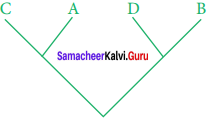
2. Paraphyletic Group: Taxon that includes an ancestor but not all of the descendants of that ancestor.
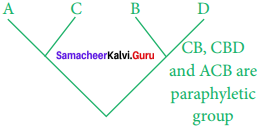
Question 17.
Why do we need Cladistics?
Answer:
Cladistics:
- Cladistics is now the most commonly used and accepted method for creating phylogenetic system of classifications.
- Cladistics produces a hypothesis about the relationship of organism to predict the morphological characteristics of organism.
- Cladistics helps to elucidate mechanism of evolution.
Question 18.
Write a note on the petals of papilionaceous Corolla.
Answer:
The outermost petal is large called standard petal or vexillum. Lateral 2 petals are lanceolate and curved. They are called wing petals or alae. Anterior two petals are partly fused and are called keel petals or carina which encloses the stamens and pistil.
Question 19.
Draw the floral diagram of Pisum sativum.
Answer:
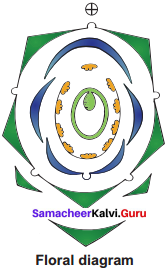
Question 20.
Write systematic position of Solanaceae based on APG classification.
Answer:
| Kingdom |
Plantae |
| 1. Clade | 1. Angiosperms |
| 2. Clade | 2. Eudicot |
| 3. Clade | 3. Asterids |
| 4. Clade | 4. Solanales |
| 5. Family | 5. Solanaceae |
Question 21.
Mention the diagnostic features of the Liliaceae member.
Answer:
The diagnostic features of Liliaceae member:
- Perennial herbs often with bulbous stem/rhizomes
- Radical leaves
- Perianth showy
- Stamens six
- Ovary superior
Question 22.
Write systematic position of Liliaceae based on Bentham and Hooker Classification?
Answer:
Systematic Position:
| Kingdom |
Plantae |
| 1. Class | 1. Monocotyledons |
| 2. Series | 2. Coronarieae |
| 3. Order | 3. Liliales |
| 4. Family | 4. Liliaceae |
IV. Long Answer Type Questions (5 Marks)
Question 1.
List out the principles of ICN.
Answer:
International Code of Nomenclature is based on the following six principles.
- Botanical nomenclature is independent of zoological and bacteriological nomenclature.
- Application of names of the taxonomic group is determined by means of nomenclatural types.
- The nomenclature of a taxonomic group is based on priority of publication.
- Each taxonomic group with a particular circumscription, position and rank can bear only one correct name, the earliest that is in accordance with the rules except in specified cases.
- Scientific names of taxonomic groups are treated as Latin regardless of their derivation.
- The rules of nomenclature are retroactive unless expressly limited.
Question 2.
Explain the role of the Botanical garden in taxonomy.
Answer:
Botanical gardens play the following important roles.
- Gardens with aesthetic value attract a large number of visitors. For example, the Great Banyan Tree (Ficus benghalensis) in the Indian Botanical Garden at Kolkata.
- Gardens have a wide range of species and supply taxonomic material for botanical research.
- Garden is used for self-instruction or demonstration purposes.
- It can integrate information of diverse fields like Anatomy, Embryology, Phytochemistry, Cytology, Physiology and Ecology.
- Act as a conservation centre for diversity, rare and endangered species.
- It offers annual list of available species and a free exchange of seeds.
- Botanical garden gives information about method of propagation, sale of plant material to the general public.
Question 3.
Enumerate the uses of Herbarium.
Answer:
The uses of Herbarium:
- Herbarium provides resource material for systematic research and studies.
- It is a place for orderly arrangement of voucher specimens.
- Voucher specimen serves as a reference for comparing doubtful newly collected fresh specimens.
- Voucher specimens play a role in studies like floristic diversity, environmental assessment, ecological mechanisms and survey of unexplored areas.
- Herbarium provides opportunity for documenting biodiversity and studies related to the field of ecology and conservation biology.
Question 4.
Point out the characters of Early angiosperm according to APG Classification.
Answer:
The characters of Early angiosperm according to APG Classification:
- Seeds always with two cotyledons.
- Presence of ethereal oils.
- Leaves are always simple net – veined
- Each floral whorls with many parts
- Perianth usually spirally arranged or parts in threes
- Stamens with broad filaments
- Anthers tetrasporangiate
- Pollen monosulcate
- Nectaries are rare
- Carpels usually free and
- Embryo very small
Question 5.
Draw a flow chart depicting the Bentham and Hooker Classification.
Answer:
Bentham and Hooker system of classification
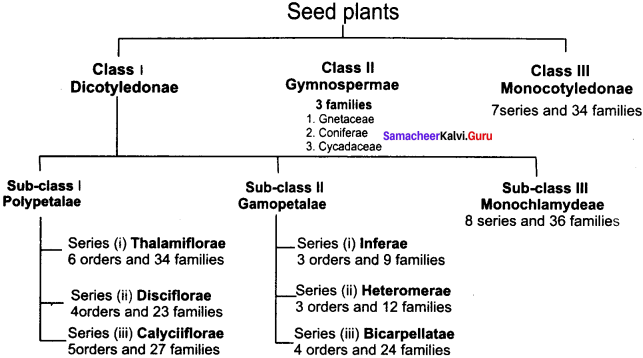
Question 6.
Draw an outline of Engler & Prantl Classification.
Answer:
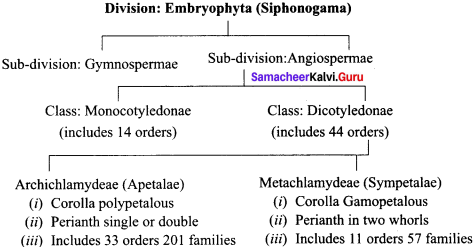
Question 7.
Note on Botanical Garden Kew London
Answer:
- Definition – Largest and most diverse botanical & mycological Collection in the world
- Location – South West London England
- Origin – 1840
- Living collection – 30,000 different kinds of plants
- Dry collection – 7 million plant specimens
- Library – more than 7,50,000 volumes & illustrations
- Prints – 1,75000 prints, books, photographs, letters, manuscripts periodicals, maps and botanical illustrations.
Question 8.
Distinguish between classical taxonomy & modern taxonomy.
Answer:
Classical Taxonomy:
- It is called old systematics or Alpha (α) – taxonomy or Taxonomy
- It is pre – Darwinian
- Species is considered a basic unit and is static
- Classification is mainly based on morphological characters
- This system is based on the observation of a few samples/individuals
Modern Taxonomy:
- It is called Neosystematics or Biosystematics or Omega (Ω) taxonomy
- It is post – Darwinian
- Species is considered a dynamic entity and ever-changing
- Classification is based on morphological, reproductive characters and the phylogenetic (evolutionary) relationship of the organism
- This system is based on the observation of a large number of samples/individuals
Question 9.
List out the significance of Molecular Taxonomy.
Answer:
The significance of Molecular Taxonomy:
- It helps to identify a very large number of species of plants and animals by the use of conserved molecular sequences.
- Using DNA data evolutionary patterns of biodiversity are now investigated.
- DNA taxonomy plays a vital role in phytogeography, which ultimately helps in genome mapping and biodiversity conservation.
- DNA – based molecular markers used for designing DNA-based molecular probes, have also been developed under the branch of molecular systematics.
Question 10.
Explain Clitoria ternatea in botanical terms. Draw a floral diagram.
Answer:

- Habit: Twining climber
- Root: Branched tap root system having nodules.
- Stem: Aerial, weak stem and a twiner.
- Leaf: Imparipinnately compound, alternate, stipulate showing reticulate venation. Leaflets are stipellate.
Petiolate and stipels are pulvinated. - Inflorescence: Solitary and axillary
- Flower: Bracteate, bracteolate, bracteoles usually large, pedicellate, heterochlamydeous, complete, bisexual, pentamerous, zygomorphic and hypogynous.
- Calyx: Sepals 5, synsepalous, green showing valvate aestivation. Odd repel is anterior in position.
- Corolla: Petals 5, white or blue apopetalous, irregular papilionaceous corolla showing, descendingly imbricate aestivation.
- Androecium: Stamens 10, diadelphous (9) + 1 nine stamens fused to form a bundle and the tenth stamen is free. Anthers are dithecous, basifixed, introse and dechising by longitudinal slits.
- Gynoecium: Monocarpellary, uni – locular, with many ovules on marginal placentation, ovary superior, style simple and incurved with feathery stigma.
- Fruit: Legume
- Seed: Non – endospermous, reniform.
- Floral Formula:

Question 11.
Explain Datura metal in botanical terms. Draw floral diagram.
Answer:
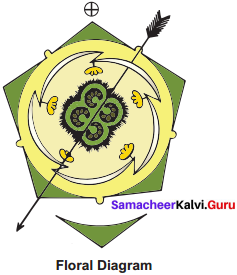
- Habit: Large, erect and stout herb.
- Root: Branched tap root system.
- Stem: Stem is hollow, green and herbaceous with strong odour.
- Leaf: Simple, alternate, petiolate, entire or deeply lobed, glabrous exstipulate showing unicostate reticulate venation.
- Inflorescence: Solitary and axillary cyme.
- Flower: Flowers are large, greenish-white, bracteate, ebracteolate, pedicellate, complete, heterochlamydeous, pentamerous, regular, actinomorphic, bisexual and hypogynous.
- Calyx: Sepals 5, green synsepalous showing valvate aestivation. Calyx is mostly persistant, odd sepal is posterior in position.
- Corolla: Petals 5, greenish-white, sympetalous, plicate (folded like a fan) showing twisted aestivation, funnel-shaped with wide mouth and 10 lobed.
- Androecium: Stamens 5, free from one another, epipetalous, altemipetalous and are inserted in the middle of the corolla tube. Anthers are basifixed, dithecous, with long filament, introse and longitudinally dehiscent.
- Gynoecium: Ovary bicarpellary, syncarpous superior ovary, basically bilocular but tetralocular due to the formation of false septum. Carpels are obliquely placed and ovules on swollen axile placentation. Style simple long and filiform, stigma two lobed.
- Fruit: Spinescent capsule opening by four special valves with persistent calyx.
- Seed: Endospermous
- Floral Formula:

Question 12.
Explain Allium cepa in botanical terms. Draw floral diagram.
Answer:
Botanical description of Allium cepa:
- Habit: Perennial herb with bulb.
- Root: Fibrous adventitious root system
- Stem: Underground bulb
- Leaf: A cluster of radical leaves emerges from the underground bulb, cylindrical and fleshy having sheathy leaf bases with parallel venation.
- Inflorescence: Scapigerous i.e. the inflorescence axis (peduncle) arising from the ground bearing a cluster of flowers at its apex. Pedicels are of equal length, arising from the apex of the peduncle which brings all flowers at the same level.
- Flower: Small, white, bracteate, bracteolate, pedicellate, complete, trimerous, actinomorphic and hypogynous. Flowers are protandrous.
- Perianth: Tepals 6, white, arranged in two whorls of three each, sympetalous showing valvate aestivation.
- Androecium: Stamens 6, arranged in two whorls of three each, epitepalous, apostamenous / free, and opposite to tepals. Anthers dithecous. basifixed, introse and dehiscing longitudinally.
- Gynoecium: Tricarpellary and syncarpous. Ovary superior, trilocular with two ovules in each locule on axile placentation. Style simple, slender with simple stigma.
- Fruit: A loculicidal capsule.
- Seed: Endospermous
- Floral Formula:

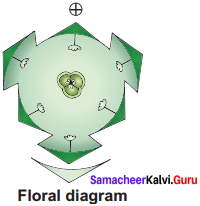
Question 13.
List out the economic importance of plants & their uses of Fabaceae.
Answer:
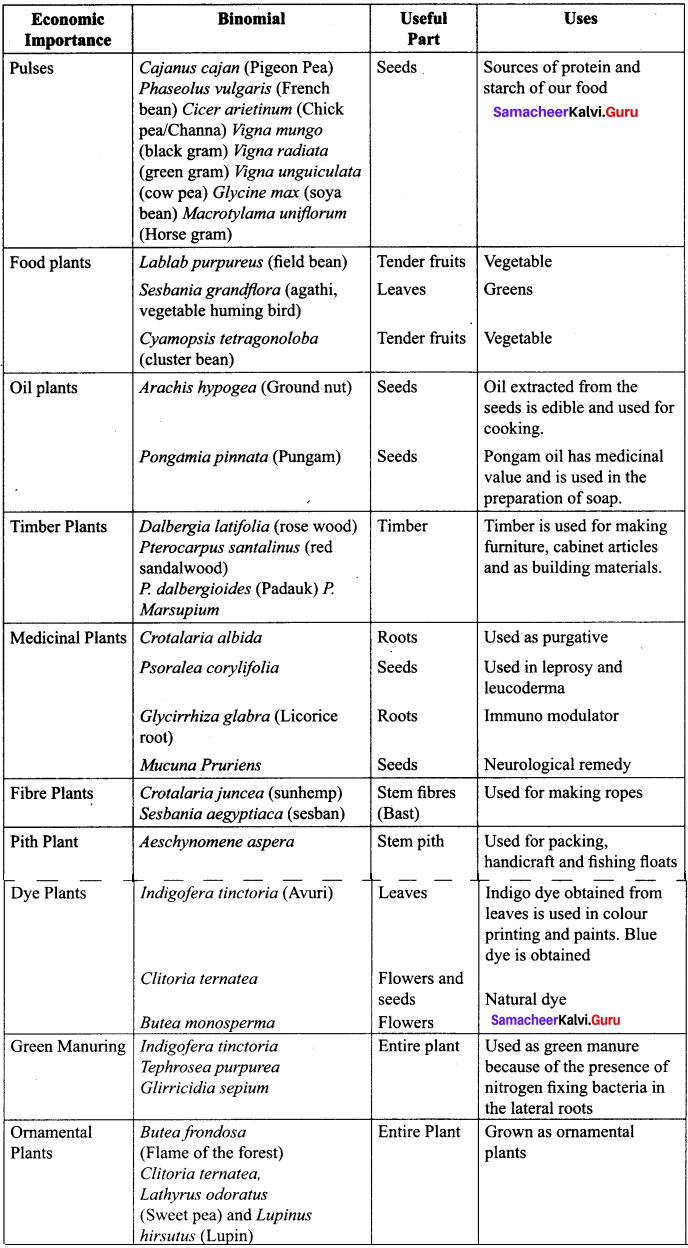
Question 14.
List out the economic importance of plants & their uses of Solanaceae.
Answer:

Question 15.
List out the economic importance of plants & their uses of Liliaceae.
Answer:
Economic Importance of the Family Liliaceae:

V. Higher Order Thinking Skills (HOTs)
Question 1.
Neem is a highly valued tree in Indian medicine. It is called the name veppu in Malayalam, Arishta in Sanskrit, Vembu in Tamil, Nimbo in Portuguese. Suggest a solution for this varied naming problem considering as a taxonomist.
Answer:
As a taxonomist, this can be solved by using Binomial nomenclature. According to ICBN, every plant is given a scientific name which can be used in common all throughout the world. Thus neem is named Azadirachta indica.
Question 2.
According to Binomial nomenclature, Human beings are named Homosapiens. Following this, write the binomials for Brinjal and Rosewood.
Answer:
The binomials for Brinjal and Rosewood:
- Brinjal – Solatium melongena
- Rosewood – Dalbergia latifolia
Question 3.
Officially, every state in the Republic of India has its own flower, fruit, etc. If Andhra Pradesh has Lotus as its state flower, what is the state flower of Tamil Nadu? Mention its family.
Answer:
State flower of Tamilnadu is Gloriosa superba belonging to the Liliaceae family.
Question 4.
Peanut is a geocarpic fruit – Comment on the statement.
Answer:
In peanut (Arachis hypogea), after fertilisation, the stipe of the ovary grows down into the soil, later develops & matures into a fruit. Such an underground developed fruit is called geocarpic fruit.
Question 5.
You are given an entire plantlet of Clitoria ternatea. Give possible reasons to say that it is a dicot plantlet.
Answer:
Clitoria ternatea belongs to Dicots because:
- The root is a taproot
- Leaves show reticulate venation
Question 6.
Give possible terms explaining the gynoecium of a flower whose C.S. of the ovary is given below.
Answer:

Tricarpellary, Trilocular, Syncarpous, 2 ovules in 1. Each ovule has axile placentation.
Hope all the information given regarding Class 11th Tamilnadu State Board Bio Botany Solutions will help you to get good knowledge. For any queries, you can contact us and clear your doubts. Connect with us using the comment section. Also, we love your feedback and review. Get your Chapter Wise Samacheer Kalvi Class 11th Textbook Solutions for Bio Botany Solutions Chapter 5 Taxonomy and Systematic Botany Questions and Answers PDF start learning for the exam.